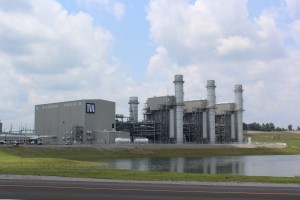From a Report by Glynis Board, Ohio Valley ReSource, WFPL – NPR, July 17, 2017
Thanks to singer-songwriter John Prine, Paradise Fossil Plant might be the only coal-fired power plant that has a household name. “Paradise,” Prine’s 1971 ballad, drew on boyhood memories from the small town of Paradise, in Muhlenberg County, Kentucky, to relay the environmental and social costs of our dependence on coal.
“Mr. Peabody’s coal train,” he sang, had hauled away the Paradise from his childhood.
On a recent hot July day down by the Green River, where Paradise lay, officials from the electricity suppliers at the Tennessee Valley Authority, or TVA, gathered to mark a milestone in the region’s energy production: the dedication of a gleaming, new billion-dollar generator to replace two of the 50-year-old coal burners nearby. This new facility, however, would burn natural gas.
“Natural gas is more flexible, it’s cheaper to operate, and also more efficient,” David Sorrick, TVA’s senior vice president of power operations, said. “The unit behind me becomes the most efficient one in the TVA fleet.”
Just a week earlier, the Trump administration’s energy secretary, Rick Perry, toured a coal-fired power plant in West Virginia to tout the president’s commitment to coal.
### Click here to explore the power switch in the Ohio Valley region ###
“The people who make their living in the coal mines running plants like this, they need to understand something,” Perry said. “They have a friend, a proponent, in the White House in Donald Trump.”
The Paradise and Longview power plants stand as examples of coal’s struggle to hold its ground against natural gas, even in the Ohio Valley, where coal has long been king. In addition to the new Paradise facility, three new natural gas power plants are pending in West Virginia, and a dozen are either in construction or planning stages in Ohio.
Despite the Trump administration’s attempts to roll back regulations on the mining and burning of coal, natural gas is rapidly becoming the power industry’s fuel of choice. It’s a switch that also brings big changes for the region’s economy, environment, and public health.
The Long View on Coal
Energy Secretary Perry recently toured North America’s youngest, most efficient coal-fired electricity plant, Longview Power near Fort Martin, West Virginia.
“This is a very enlightening stop,” Perry said. “This technology, this ability to deliver a secure, economical, environmentally good source of energy is really important.”
A 20-day supply of coal is always stockpiled at the plant, fed directly from the mouth of a nearby coal mine via a conveyor belt that stretches more than 4 miles. About 600 employees work together to keep rock burning hot to boil water in the deafening plant.
“This is the turbine building,” Longview manager Chad Hufnagle shouted during a tour. “The turbine is basically where we take the steam from the boiler, we rotate the turbine to take the mechanical energy into electrical.”
READ NEXT: Perry’s Coal Economics Leaves Economists Puzzled
Longview generates 700 megawatts of electricity for the region and it does so with far less pollution than most older coal burners in the nation’s fleet of power plants. Longview officials say the plant produces 90 percent less particulate pollution than other coal plants. It also produces less carbon dioxide compared to other coal plants, because of its high efficiency and partial use of natural gas as a complementary fuel.
Longview does not capture and store the carbon dioxide emissions, however, something generally thought of as part of “clean coal” technology. That technology suffered a major setback when the operators of the $7 billion Kemper facility in Mississippi pulled the plug on a planned clean coal facility and decided instead to switch to natural gas.
Secretary Perry and many federal lawmakers see big benefits in keeping coal-fired power going, and if coal is going to have a future, it will probably be with plants like Longview.
“This plant — and I won’t say plants like it, because there’s not a lot like it — is incredibly important to the future of this country,” Perry said.
But Longview’s short history shows the many hurdles coal power faces. Plans were drawn for Longview in 2001 and the plant met resistance from local residents who sued to stop it. After winning the necessary permits Longview’s owners secured financing in 2007 and started operation in 2011.
Just two years later, however, the operating company filed for bankruptcy protection as electricity demand fell and competition from cheaper natural gas rose. The company emerged from bankruptcy just two years ago. Officials now say the facility’s high efficiency helps make it competitive in a tough market.
That sort of bumpy start helps explain why few coal powered facilities are slated for construction.
Perry is waiting for an analysis he has ordered of the country’s electrical grid. He expects that report will demonstrate need for the kind of constant, uninterrupted power coal can provide.


{ 1 comment… read it below or add one }
“Man is incapable of understanding any argument
that interferes with his revenue.”
- – Rene Descartes (1598-1650)